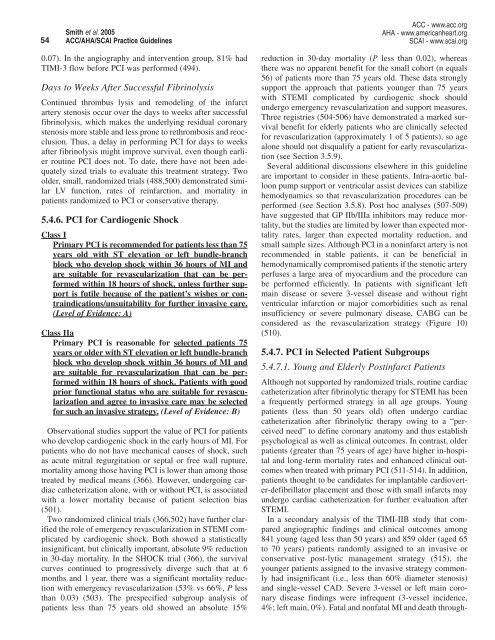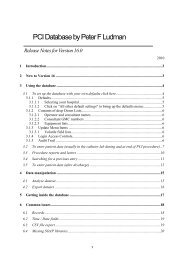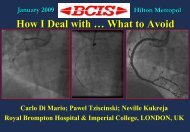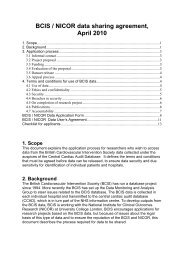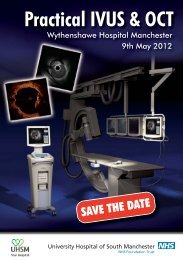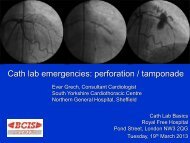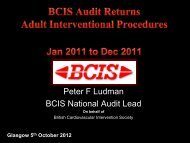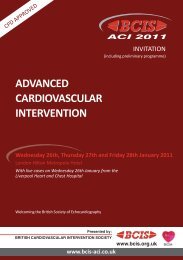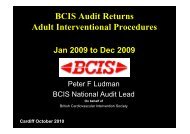Recommendations
ACC/AHA/SCAI PCI Guidelines - British Cardiovascular Intervention ...
ACC/AHA/SCAI PCI Guidelines - British Cardiovascular Intervention ...
- No tags were found...
You also want an ePaper? Increase the reach of your titles
YUMPU automatically turns print PDFs into web optimized ePapers that Google loves.
54<br />
Smith et al. 2005<br />
ACC/AHA/SCAI Practice Guidelines<br />
ACC - www.acc.org<br />
AHA - www.americanheart.org<br />
SCAI - www.scai.org<br />
0.07). In the angiography and intervention group, 81% had<br />
TIMI-3 flow before PCI was performed (494).<br />
Days to Weeks After Successful Fibrinolysis<br />
Continued thrombus lysis and remodeling of the infarct<br />
artery stenosis occur over the days to weeks after successful<br />
fibrinolysis, which makes the underlying residual coronary<br />
stenosis more stable and less prone to rethrombosis and reocclusion.<br />
Thus, a delay in performing PCI for days to weeks<br />
after fibrinolysis might improve survival, even though earlier<br />
routine PCI does not. To date, there have not been adequately<br />
sized trials to evaluate this treatment strategy. Two<br />
older, small, randomized trials (488,500) demonstrated similar<br />
LV function, rates of reinfarction, and mortality in<br />
patients randomized to PCI or conservative therapy.<br />
5.4.6. PCI for Cardiogenic Shock<br />
Class I<br />
Primary PCI is recommended for patients less than 75<br />
years old with ST elevation or left bundle-branch<br />
block who develop shock within 36 hours of MI and<br />
are suitable for revascularization that can be performed<br />
within 18 hours of shock, unless further support<br />
is futile because of the patient’s wishes or contraindications/unsuitability<br />
for further invasive care.<br />
(Level of Evidence: A)<br />
Class IIa<br />
Primary PCI is reasonable for selected patients 75<br />
years or older with ST elevation or left bundle-branch<br />
block who develop shock within 36 hours of MI and<br />
are suitable for revascularization that can be performed<br />
within 18 hours of shock. Patients with good<br />
prior functional status who are suitable for revascularization<br />
and agree to invasive care may be selected<br />
for such an invasive strategy. (Level of Evidence: B)<br />
Observational studies support the value of PCI for patients<br />
who develop cardiogenic shock in the early hours of MI. For<br />
patients who do not have mechanical causes of shock, such<br />
as acute mitral regurgitation or septal or free wall rupture,<br />
mortality among those having PCI is lower than among those<br />
treated by medical means (366). However, undergoing cardiac<br />
catheterization alone, with or without PCI, is associated<br />
with a lower mortality because of patient selection bias<br />
(501).<br />
Two randomized clinical trials (366,502) have further clarified<br />
the role of emergency revascularization in STEMI complicated<br />
by cardiogenic shock. Both showed a statistically<br />
insignificant, but clinically important, absolute 9% reduction<br />
in 30-day mortality. In the SHOCK trial (366), the survival<br />
curves continued to progressively diverge such that at 6<br />
months and 1 year, there was a significant mortality reduction<br />
with emergency revascularization (53% vs 66%, P less<br />
than 0.03) (503). The prespecified subgroup analysis of<br />
patients less than 75 years old showed an absolute 15%<br />
reduction in 30-day mortality (P less than 0.02), whereas<br />
there was no apparent benefit for the small cohort (n equals<br />
56) of patients more than 75 years old. These data strongly<br />
support the approach that patients younger than 75 years<br />
with STEMI complicated by cardiogenic shock should<br />
undergo emergency revascularization and support measures.<br />
Three registries (504-506) have demonstrated a marked survival<br />
benefit for elderly patients who are clinically selected<br />
for revascularization (approximately 1 of 5 patients), so age<br />
alone should not disqualify a patient for early revascularization<br />
(see Section 3.5.9).<br />
Several additional discussions elsewhere in this guideline<br />
are important to consider in these patients. Intra-aortic balloon<br />
pump support or ventricular assist devices can stabilize<br />
hemodynamics so that revascularization procedures can be<br />
performed (see Section 3.5.8). Post hoc analyses (507-509)<br />
have suggested that GP IIb/IIIa inhibitors may reduce mortality,<br />
but the studies are limited by lower than expected mortality<br />
rates, larger than expected mortality reduction, and<br />
small sample sizes. Although PCI in a noninfarct artery is not<br />
recommended in stable patients, it can be beneficial in<br />
hemodynamically compromised patients if the stenotic artery<br />
perfuses a large area of myocardium and the procedure can<br />
be performed efficiently. In patients with significant left<br />
main disease or severe 3-vessel disease and without right<br />
ventricular infarction or major comorbidities such as renal<br />
insufficiency or severe pulmonary disease, CABG can be<br />
considered as the revascularization strategy (Figure 10)<br />
(510).<br />
5.4.7. PCI in Selected Patient Subgroups<br />
5.4.7.1. Young and Elderly Postinfarct Patients<br />
Although not supported by randomized trials, routine cardiac<br />
catheterization after fibrinolytic therapy for STEMI has been<br />
a frequently performed strategy in all age groups. Young<br />
patients (less than 50 years old) often undergo cardiac<br />
catheterization after fibrinolytic therapy owing to a “perceived<br />
need” to define coronary anatomy and thus establish<br />
psychological as well as clinical outcomes. In contrast, older<br />
patients (greater than 75 years of age) have higher in-hospital<br />
and long-term mortality rates and enhanced clinical outcomes<br />
when treated with primary PCI (511-514). In addition,<br />
patients thought to be candidates for implantable cardioverter-defibrillator<br />
placement and those with small infarcts may<br />
undergo cardiac catheterization for further evaluation after<br />
STEMI.<br />
In a secondary analysis of the TIMI-IIB study that compared<br />
angiographic findings and clinical outcomes among<br />
841 young (aged less than 50 years) and 859 older (aged 65<br />
to 70 years) patients randomly assigned to an invasive or<br />
conservative post-lytic management strategy (515), the<br />
younger patients assigned to the invasive strategy commonly<br />
had insignificant (i.e., less than 60% diameter stenosis)<br />
and single-vessel CAD. Severe 3-vessel or left main coronary<br />
disease findings were infrequent (3-vessel incidence,<br />
4%; left main, 0%). Fatal and nonfatal MI and death through-


